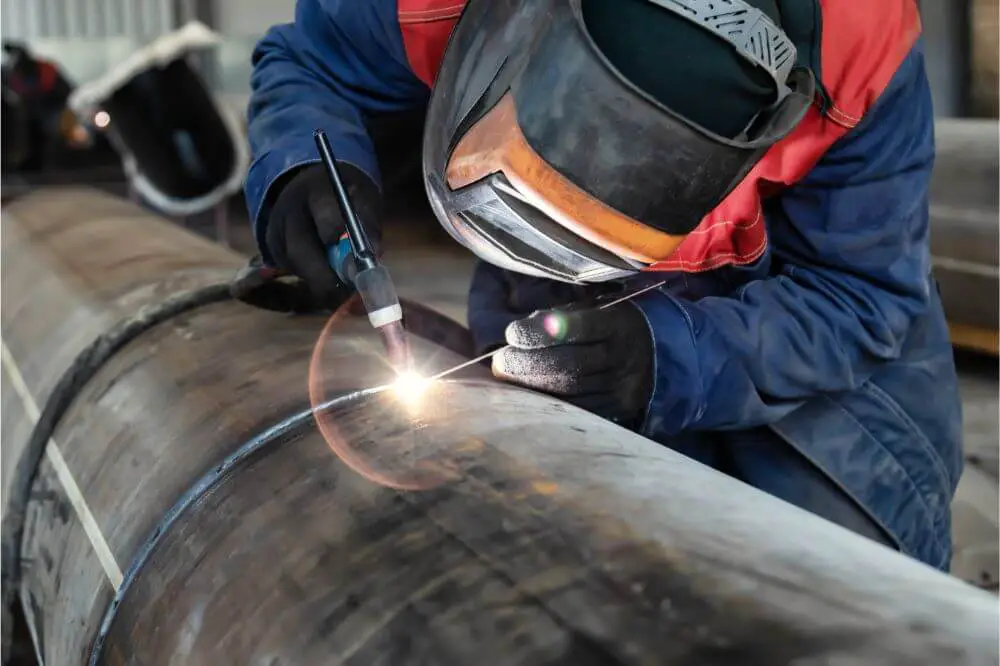MIG welding and stick welding are two common types of welding, and both are used to join two base metals together.
If you are just getting into welding, and have never done it before, you probably want to start with the easiest type of welding.
Now, technically speaking, most people will tell you that MIG welding is ideal for beginners and quite easy to learn, with some people saying that it is not much harder than using a glue gun.
Stick welding is also not that hard, but the results between these two types of welding can differ.
So, which is better – MIG or stick welding for beginners? What are the differences between these two types of welding?
MIG Welding
This type of welding involves using a wire welding electrode that is on a spool and is automatically fed into the welder.
Through the use of an electrical current, an arch is generated, which in essence is a lot of heat and electricity that binds two base metals together. The hot current melts the wire and the base metals, thus forming a solid connection.
MIG welding is often considered to be the easiest type of welding, as it is both easy to perform and to clean once the weld has been made.
Most people can learn how to MIG weld in just a couple of weeks without issue.
However, MIG welding can be hard to learn for two reasons – finding the proper shielding gasses to use for the specific application, and setting the right parameters on the MIG welder.
However, once these two issues have been solved, it’s more or less a point-and-shoot situation.
MIG welding is ideal because it can be used to make very strong bonds that look great and don’t need much cleaning once complete. MIG welders can weld all sorts of metals together and can perform very thin and precise work.
Pros
- Can be very precise – especially with thin materials
- Clean, smooth, and usually slag free
- There are no interruptions as you use a continuous spool
- Easy to learn in a couple of weeks
- Can be used to create intricate designs
- Can be very fast
Cons
- The metal must be completely clean
- Wind can disrupt the shielding gasses, thus causing issues
- It requires large canisters of shielding gas
Stick Welding
Stick welding is a bit different. Instead of using a wire on a spool, this type of welding uses a metal stick that is charged to create a super-hot arc. This process involves the formation of an arc or current between the stick and the base metals.
This is a very popular and common type of welding, particularly for electricians and shop owners.
Stick welding is very effective for forming joints between various metals, and it is a type of welding that can be performed both indoors and outdoors.
One benefit of stick welding is that it is the cheapest way to weld, and a second benefit is that it can be done with dirty and rusty metals.
That said, stick welding gets very hot, which means that it can overheat thin metals, plus this type of welding creates a lot of spatter that needs to be cleaned once the welding is complete.
Moreover, stick welding is considered somewhat difficult to learn, as it involves striking an arc between the stick and the base metal.
Both striking and maintaining the arc involves maintaining a certain distance between the stick and the metal; this is one of the hardest aspects of stick welding, and mastering this can take months to master.

Pros
- Stick welding is ideal as it allows the user to weld rusty and dirty metals, and it doesn’t matter if there is paint present
- Attaching a ground clamp to hold the metal in place is easily done
- Stick welding features a large arc that is not affected by wind
- Exchanging rods is easily done
- Can be done both indoors and outdoors
Cons
- Stick welding creates a lot of spatter and therefore leaves a large slag deposit behind. This slag then needs to be scraped or chipped away
- The spatter created can be dangerous
- Striking and maintain an arc is hard
- Switching the metal stick is necessary once the previous one is used up, and this interrupts the process
- Welding anything less than ½ inch thick is near impossible
Conclusion
If you are just starting with welding, you will want to start with MIG welding, as it is much easier than stick welding.

